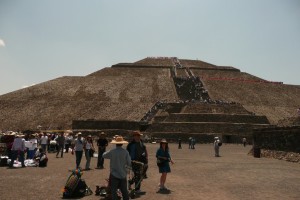The Mexican National Institute of Anthropology and History (INAH) has announced its most important discoveries for 2013, amongst which figure the discovery of the tail of a hadrosaur in the state of Coahuila and the prehispanic settlement of Chactún in the southern state of Campeche on the Yucatan Peninsula.
The most notable of these findings are:
![Parasaurolophus cyrtocristatus skeleton, Field Museum. |Source=[http://www.flickr.com/photos/8193351@N03/1345351768/ Field Museum Dinosaur] |Date=October 01, 2006 at 00:00 |Author=[http://www.flickr.com/people/8193351@N03 Lisa A](https://zihrena.net/wp-content/uploads/20080527181852Parasaurolophus_cyrtocristatus-300x225.jpg)
Parasaurolophus cyrtocristatus skeleton, Field Museum. |Source=[http://www.flickr.com/photos/8193351@N03/1345351768/ Field Museum Dinosaur] |Date=October 01, 2006 at 00:00 |Author=[http://www.flickr.com/people/8193351@N03 Lisa A
In the northern state of Coahuila, in the municipality of General Cepeda, the complete spine and tail of a hadrosaur or duck-billed dinosaur, who wandered the area some seventy-five million years ago, was unearthed.
The hadrosaurs are known as the duck-billed dinosaurs due to the similarity of their head to that of modern ducks. In some genera, most notably Anatotitan, the whole front of the skull was flat and broadened out to form a beak, which was ideal for clipping leaves and twigs from the forests of Asia, Europe and North America. However, the back of the mouth contained thousands of teeth suitable for grinding food before it was swallowed.
Wikipedia contributors, “Hadrosaurid,” Wikipedia, The Free Encyclopedia, http://en.wikipedia.org/w/index.php?title=Hadrosaurid&oldid=588470660 (accessed January 3, 2014).
In the southwestern portion of Campeche, just to the north of the Rio Bec area, archaeologists discovered the prehispanic settlement of Chactún. It comprises three monumental structures, the highest of which measures twenty-three meters, and many smaller pyramidal forms, palaces, two ball courts, patios, plazas, sculptures, and living quarters. The area also holds nineteen Maya steles.
In Teotihuacan, state of Mexico, the pinnacle of the Pyramid of the Sun rendered up the tallest sculpture to date of the old fire god, Huehuéteotl, measuring fifty-eight centimeters in height and weighing 190 kilos. The sculpture still retains some of the original pigments. Two intact green stone steles and part of a third were also discovered; they are thought to perhaps have served as temple decorations dating from some fifteen hundred years ago.
Using modern technology, archeological robot Tláloc II-TC reached into the last portion of the tunnel located under the Temple of the Plumed Serpent at Teotihuacan. The robot identified three new chambers. In two other previously-discovered chambers, Tláloc II-TC detected adobe walls, as well as an unusual offering up upwards of one hundred metallic spheres dating from one thousand eight hundred years ago.

Teotihuacan Pyramid of the Sun
In Mexico City, very close to the Museo Nacional de las Intervenciones in Churubusco, Coyoacán, an archaeological crew located a Mexica platform, a prehispanic offering site, vestiges of architecture from the viceregal period, and military artifacts used during the US-Mexican war of 1847. Crews identified and unearthed many other funerary, ritual offering, and burial sites in the area of the Templo Mayor of Tenochitlan and other sites within the historical center of the city.
Institute personnel discovered panels of rock etchings at “Cantil de las Ánimas,” Tepic, Nayarit, the largest of which measures almost four meters long by two meters wide; these are thought to date from between 850 and 1350 AD.
Off the coast of the Yucatan to the north of Alacranes reef, underwater crews located the remains of British ship HMS Forth, which had been shipwrecked in 1949. During the 2013 season, a further fourteen shipwrecks from the 19th and 20th centuries were pinpointed.
At Palenque, two cavities measuring two to three meters in size were identified via radar within the Temple of the Inscriptions.
At Xtojil, 20 kilometers from Chichén Itzá, a dozen burial sites were found from which were recuperated thirty pieces of ceramics, most likely dating from 600 to 800 AD.
In Baja California, just south of Mexicali, eight new archaeological sites gave up animal bones, ceramics, and stone artifacts in the rocky crags of the Sierra del Mayor. To the north of Ensenada, INAH archaeologists located 109 sites dating as far back as three thousand years that are thought to be seasonal camps of hunter-gatherers and fisherman, one site of of which includes rock paintings.
Within the Convento de Santiago Apóstol located at Ocuituco, Morelos, specialists found fourteen skeletons dating from the sixteenth to eighteenth centuries. Amongst the most notable is the grave of an infant that shows a combination of viceroyal and prehispanic burial traditions: a nailed, wooden coffin containing two small clay figurines.
In Tula, Hidalgo, in the atrium of the Cathedral of San José, vestiges of buildings dating from the first half of the sixteenth century were discovered as well as buildings of Toltec origin 500 to 1,000 years old, which were later modified by the mexicas.
For more information, see: http://www.inah.gob.mx/boletines/17-arqueologia/6994-hallazgos-enriquecieron-patrimonio-historico-de-mexico